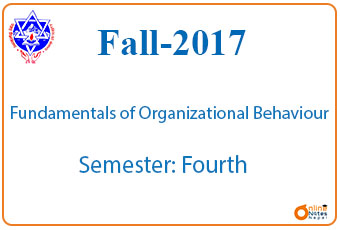Published by: sadikshya
Published date: 25 Jun 2021

This is the question set along with answers to Fundamentals of Organizational Behaviour Fall 2017, which was taken by the Pokhara University.
Pokhara University – Fundamentals of Organizational Behaviour Fall 2017
| Level: Bachelor | Semester –Fall | Year: 2017 |
| Program: BBA/BBA-BI/BBA-TT/BCIS | Full Marks: 100 | |
| Course: Fundamentals of Organizational Behaviour | Pass Marks: 45 | |
| Time: 3hrs. | ||
Section “A”
Very Short Answer Questions
Attempt all the questions.
Section “B”
Descriptive Answer Questions
Attempt any six questions
11. What is workforce diversity& how has it created challenges and opportunities? How does today’s manager overcome these problems?
12. State different factors affecting perception. Explain the specific application of perception in organizational decision making.
13. What do you understand by organizational structure and what are the types of structure found in our society? Why does an organizational structure differ?
14. Is conflict necessary in an organization? Write about the interactionist view of conflict?
15. Discuss the importance of organisational culture. How can an organization create and sustain an organisational culture?
16. Organizational productivity depends on leadership style and approach. But the choice of leadership style should be situational. In light of this statement, state and explain Fred Fiedler’s contingency theory of leadership with usefulness and criticism.
17. Explain the concept of organizational development (OD). State and explain different OD interventions that managers can use in Nepalese organizations.
Section”C”
Case Analysis
DIFFICULT TRANSITIONS
18. Stark had just finished his first week at Reece Enterprises and decided to drive upstate to a small lakefront lodge for some fishing and relaxation. Stark had worked for the previous ten years for the O’Grady Company, but O’Grady had been through some hard times and had recently shut down several of its operating groups, including Stark’s, to cut costs. Fortunately, Stark’s experience and recommendations had made finding another position fairly easy. As he drove the interstate (divided highway), he reflected on the past 10 years and the apparent (visible) situation at Reece.
At O’Grady, things had been great. Stark had been part of the team from day one. The job had met his personal goals and expectations perfectly, and Stark believed he had grown greatly as a person. His work was appreciated and recognized; he had received three promotions and many more pay increases. The firm was decentralized, allowing its manager’s considerable autonomy and freedom. The corporate culture was easy-going. Communication was open. It seemed that everyone knew what was going on at all times, and if you didn’t know about something, it was easy to find out.
The social environment was another plus point. Stark and three other managers go for lunch often and played golf every Saturday. They got along well both personally and professionally and truly worked together as a team. Their boss had been very supportive, giving them the help they needed but also staying out of the way and letting them work.
As Stark drove, he reflected that “comparable” probably was the wrong word. Indeed, Reece and O’Grady were about as different as you could get. Top managers at Reece apparently didn’t worry too much about who did a good job and who didn’t. They seemed to promote and reward people based on how long they had been there and how well they played the never-ending political games.
Maybe this stemmed from the organization itself, Stark pondered. Reece was a bigger organization than O’Grady and was structured much more bureaucratically. It seemed that no one was allowed to make any sort of decision without getting three signatures from higher up. Those signatures, though, were hard to get. All the top managers usually were too busy to see anyone, and interoffice memos apparently had very low priority.
Stark also had had some problems fitting in. His peers treated him with polite indifference. He sensed that a couple of them resented that he, an outsider, had been brought right in at their level after they had had to work themselves up the ladder.
Case Questions
a) Is it possible to find an “ideal” place to work? Explain how this new situation will affect Stark’s commitment to being in the organization.
b) Do you think Open Communication is good for the organization? What possible advantage and disadvantage you suggest regarding communication in two organizations?
c) Make a comparison that Stark wants to reflect for the leadership style in O’Grady and Reece Enterprises. Base your assessment on the Behavioural theory of leadership.
d) Do you believe that the success of an organization depends on the bureaucratic or democratic organization? Give your answer based on the characteristics of these structures.